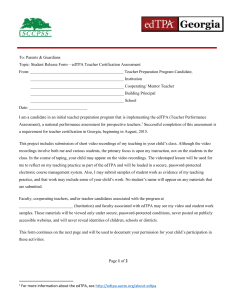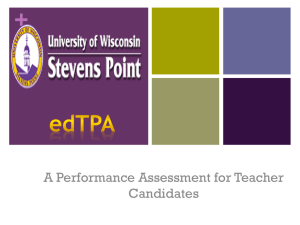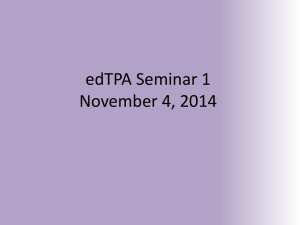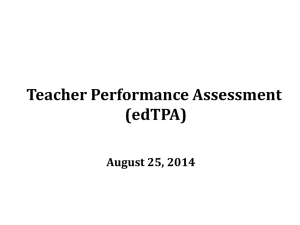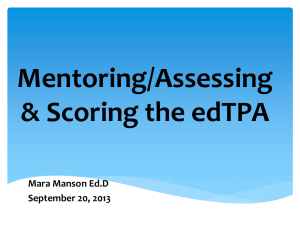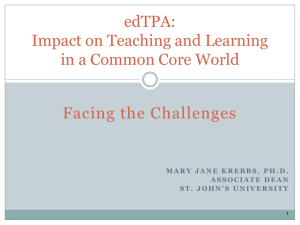+ Cooperating Teacher Workshop August 18, 2015
advertisement
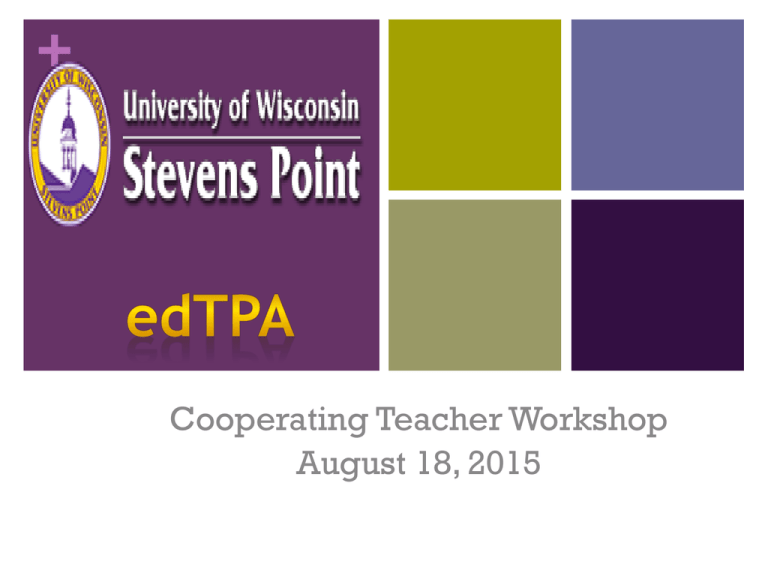
+ Cooperating Teacher Workshop August 18, 2015 + Overview Why edTPA for Wisconsin? Where What does edTPA come from? does edTPA look like? What does edTPA mean for our schools and classrooms? What does edTPA mean for us? + edTPA Was created by Stanford University with input from teachers and teacher educators Supports candidate learning and preparation, program growth and renewal Is a measure of readiness to teach Is based on NBPT Standards Informs program completion and licensure decisions Is supported by AACTE + Wisconsin DPI Introduction to edTPA State Superintendent Tony Evers http://www.youtube.com/watch?v=lD 4KuGIHwo4 + edTPA Is grounded in demonstrating practices and focuses on student learning Aligns with INTASC Standards Aligns with the Framework for Teaching Prepares candidates for expectations of Educator Effectiveness Complementary to the PDP process + Architecture of the edTPA + 8 edTPA Rubric Blueprint Task name: Rubric Title Guiding Question Level 1 Level 2 Level 3 Level 4 Level 5 Represents the knowledge and skills of a seriously struggling candidate who is not ready to teach Represents the knowledge and skills of a candidate who is possibly ready to teach Represents the knowledge and skills of a candidate who is qualified to teach Represents a candidate with a solid foundation of knowledge and skills for a beginning teacher Represents the advanced skills and abilities of a candidate very well qualified and ready to teach + Task #1: Planning for Instruction & Assessment Artifacts include: Context for Learning, Lesson Plans, Instructional Materials, Assessments, Commentary Planning for Learning Planning to Support Varied Student Learning Needs Using Knowledge of Students to Inform Teaching & Learning Identifying & Supporting Language Demands Planning Assessments to Monitor & Support Student Learning + Task #2: Instructing & Engaging Students in Learning Artifacts Include: Video Clip(s), Commentary Learning Environments Engaging Students in Learning Deepening Student Learning Subject-Specific Pedagogy Analyzing Teaching Effectiveness + Task #3: Assessing Student Learning Artifacts include: Student Work Samples, Evidence of Feedback, Evaluation Criteria Commentary Analysis of Student Learning Providing Feedback to Guide Further Learning Student Use of Feedback Analyzing Students’ Language Use and Literacy Using Assessment to Inform instruction + Mechanics Chalk & Wire will be the platform used at UWSP to store, edit, complete, and submit the edTPA Portfolio Evaluation, scoring, and delivery of results to candidates and programs is conducted by Pearson + Timeline Fall 2014-2015 UWSP Pilot edTPA to Pearson (20 students) Spring 2014-2015 All UWSP teacher candidates pilot edTPA with Local Evaluation, pilot sample to Pearson 2015-2016 All teacher candidates statewide complete edTPA and submit to Pearson Wisconsin standard setting year 2016-2017 Passing score required for teaching certification and licensure + Resources for Assistance with edTPA UWSP School of Education-edTPA http://www.uwsp.edu/education/Pages/e dtpa.aspx Wisconsin Department of Public Instruction http://tepdl.dpi.wi.gov/epp/edtpa Chalk & Wire www.chalkandwire.com + Campus Contacts for Support with edTPA Cathleen Olds Director of Field Experience, UWSP colds@uwsp.edu Leslie McClain Professor, School of Education, UWSP lmcclain@uwsp.edu + Architecture of the edTPA + Task #1: Planning for Instruction & Assessment Artifacts include: Context for Learning, Lesson Plans, Instructional Materials, Assessments, Commentary Let’s begin with the Professional Ed Program Lesson Plan Framework (see handout) + UWSP Professional Education Program Lesson Plan Framework Please use this framework to design your plans for effective instruction. The embedded shaded guidelines and questions will help you consider aspects to address as you prepare your plan. Be sure to keep in mind the Gradual Release of Responsibility Model as you write your plan. Remember this learning model guides the learner through teacher modeling and demonstration, shared teacher/learner demonstration, learner guided practice, and learner independent practice. + First: General Information + Then: Contextual Information Type of school List any special features of the school or classroom setting Describe any district, school, or cooperating teacher expectations that might affect planning or delivery of instruction + Contextual Information cont… Also address the following points related to learners: The children in the class Explain required or needed supports, accommodations or modifications for your learners that will affect the instruction in this learning segment. Include the variety of learners in the classroom + Next: The Lesson Central Focus Essential Questions Connections with Academic of Common Core Standards Objectives Consider assessments (formative) Academic Prior Language Knowledge + Lesson Procedure Note: Be sure to work with the guiding questions in the Lesson Plan Framework which will help in describing the procedures + Lesson Plan Commentary This section will describe the rationale for the lesson – describe the thinking behind the decision making. Integrate background and theoretical foundations learned in the course of study – including Foundations and Methods courses. Work with the guiding questions on the Lesson Plan Framework to help develop the commentary. + An Example Just to show you a sample of a lesson plan and commentary designed for an elementary lesson…. + Architecture of the edTPA + Task #2: Instructing & Engaging Students in Learning Obtain permission for video recording (UW-System and WSBA permission form) Examine plans for the learning segment & identify tasks where teacher candidate and students are actively engaged Remember - video clips must include aspects specified in the 2015 edTPA Handbook + Task #2: Instructing & Engaging Students in Learning cont…. Know the specific guidelines for clips that are to be included (content & number) Decide who will be included in the clip (Whole class? Targeted sample?) Read through tips for video recording (become familiar with and practice using the technology prior to recording the lessons) + Task #2: Instructing & Engaging Students in Learning - Commentary Explains which lesson(s) is included Demonstrates promoting a positive learning environment Engages student learning Deepens student learning during instruction Analyzes teaching (with reference to the video clips) + Task #2: Instructing & Engaging Students in Learning – few tips Explains Identify which lesson(s) is included lessons by lesson plan number Promoting Good a positive learning environment rapport and respect High Order Thinking Skill (HOTs) vs. Low Order Thinking (LOTS) questioning strategies Know the students’ names Low risk environment + Task #2: Instructing & Engaging Students in Learning – few tips Engages student learning Collaborative activities Making personal or cultural connection to lesson Prior knowledge to the lesson Deepens student learning Discussions - student-teacher/student-student Student critique and comments allow for evaluative thinking and understanding + Task #2: Instructing & Engaging Students in Learning – few tips Analyzes teaching (with reference to video clips) Changes that could improve instruction Identify specific examples from the video Relevant theory and research Other supportive activities for instruction + Task #2: Instructing & Engaging Students in Learning – Video tips Before video recording the lessons: Collect consent forms Students without consent (Face blur--last resort) Students engaging/ discussing/ collaborating Practice! Practice!! Practice!!! During video session Assumption – no video taping going on Capture & zoom in on important segments Project “teacher’s voice” + Architecture of the edTPA + Task #3: Assessing Student Learning Determine which assessment from the learning segment used to evaluate the students… Define and submit the evaluation criteria Collect and analyze student work to identify quantitative and qualitative patterns of learning (note guidelines for submission of student work) + Task #3: Assessing Student Learning cont… Select specific student work samples that represent the patterns of learning Document feedback given to specific students Provide evidence of students’ understanding and use of academic language + Task #3: Assessing Student Learning - Commentary Identify your specific learning objectives and standards Provide a chart or narrative that summarizes student learning for the whole class. Use evidence from specific student work samples and the whole class to analyze patterns + Task #3: Assessing Student Learning - Commentary Refer to specific feedback given to support explanations. Provide evidence of students’ use of academic language Describe next steps for instruction + In Conclusion and In General edTPA has three tasks: planning, instruction and assessment Guidelines for these tasks are designed specifically for each program area and will vary across areas + The Role of the Cooperating Teacher and University Supervisor As the Teacher Candidate completes edTPA Tasks, ask probing and clarification questions as needed by the candidate while completing this process. We cannot edit the Teacher Candidates’ edTPA, but peers, Supervisors and Cooperating Teachers may offer general critique. We cannot do it for them. We can be supportive in the completion of the 3 Tasks. edTPA submission date is October 29, 2015 (small number of students will submit the edTPA December 23, 2015). + Thank you for joining us and for supporting our Teacher Candidates! Note: New Cooperating Teachers please stay.

